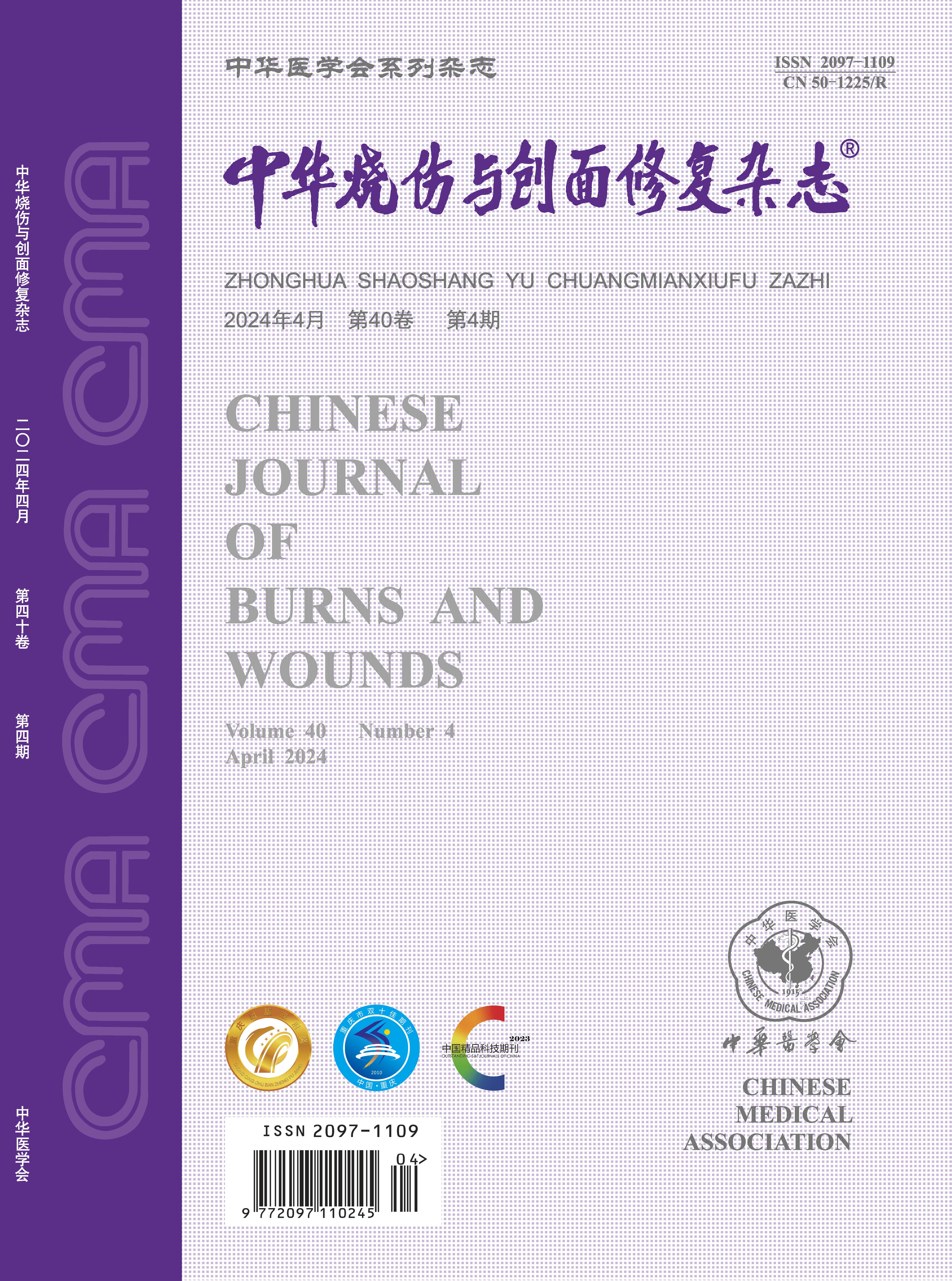Abstract:
Objective To prepare advanced platelet-rich fibrin (A-PRF)/chitosan temperature-sensitive hydrogel (hereinafter referred to as composite hydrogel) and explore the effects of composite hydrogel on full-thickness skin defect wound healing in diabetic rats. Methods This study was an experimental study. The composite hydrogel with porous mesh structure and temperature-sensitive characteristics was successfully prepared, containing A-PRF with mass concentrations of 10, 15, 20, 50, and 100 g/L. Diabetic model was successfully established in male Sprague-Dawley rats aged 6-8 weeks by intraperitoneal injection of streptozotocin, and 4 full-thickness skin defect wounds were established on the back of each rat (finally 36 rats were successfully established model). Three wounds of each rat were divided into blank group (no drug intervention), positive control group (dropping recombinant human granulocyte-macrophage stimulating factor gel), and chitosan hydrogel group (dropping chitosan hydrogel solution); the remaining one wound of each rat (totally 30 wounds) was added with composite hydrogel solution containing 10, 15, 20, 50, and 100 g/L A-PRF, respectively, and the wounds were set as 10, 15, 20, 50, and 100 g/L composite hydrogel groups, with 6 wounds in each group. On 14 d after injury, 6 rats with one wound in 100 g/L composite hydrogel group were selected for hematoxylin-eosin (HE) staining to observe the inflammation, hemorrhage, or necrosis of the heart, liver, spleen, lung, and kidney. On 10 d after injury, 6 rats with one wound in 15 g/L composite hydrogel group were selected to observe the blood flow perfusion of wounds in the four groups (with sample size of 6). On 0 (immediately), 7, and 14 d after injury, the wound healing in the eight groups was observed and the wound healing rate was calculated. On 14 d after injury, the wound tissue in the eight groups was taken for HE and Masson staining to observe the formation of new epithelium and collagen formation, respectively; the expressions of CD31 and vascular endothelial growth factor A (VEGFA) were detected by immunohistochemistry; the protein expressions of CD31 and VEGFA were detected by Western blotting; the mRNA expressions of CD31 and VEGFA were detected by real-time fluorescent quantitative reverse transcription polymerase chain reaction (with all sample sizes of 4). Results On 14 d after injury, no obvious inflammation, hemorrhage, or necrosis was observed in the heart, liver, spleen, lung, and kidney in the 6 rats. On 10 d after injury, the blood perfusion volume of wound in 15 g/L composite hydrogel group was significantly more than that in blank group, positive control group, and chitosan hydrogel group, respectively (with P values all <0.05). On 7 and 14 d after injury, the wound healing rates of blank group were (26.0±8.9)% and (75.0±1.8)%, which were significantly lower than those of positive control group, chitosan hydrogel group, and 10, 15, 20, 50, 100 g/L composite hydrogel group ((45.8±3.2)%, (49.8±3.7)%, (51.2±2.9)%, (68.5±2.4)%, (68.8±1.5)%, (72.7±2.1)%, (75.0±3.7)% and (79.1±1.9)%, (77.2±1.7)%, (82.3±1.3)%, (89.6±1.9)%, (89.8±1.3)%, (87.3±1.1)%, (87.9±1.3)%), P<0.05; the wound healing rates of positive control group, chitosan hydrogel group, and 10 g/L composite hydrogel group were significantly lower than those of 15, 20, 50, and 100 g/L composite hydrogel group ( P<0.05). On 14 d after injury, the wound epidermization degrees of rats in 15, 20, 50, and 100 g/L composite hydrogel groups were higher than those in the other 4 groups, and the new microvascular situation was better, and the number of collagen was more and arranged more neatly. On 14 d after injury, the percentages of CD31 and VEGFA positive areas in wounds in positive control group and the percentage of VEGFA positive area in wounds in chitosan hydrogel group were significantly higher than those in blank group ( P<0.05), the percentage of VEGFA positive area in wounds in 10 g/L composite hydrogel group was significantly higher than that in blank group, chitosan hydrogel group, and positive control group (with P values all <0.05), and the percentages of CD31 and VEGFA positive areas in wounds in 15, 20, 50, and 100 g/L composite hydrogel groups were significantly higher than those in blank group, positive control group, chitosan hydrogel group, and 10 g/L composite hydrogel group ( P<0.05). On 14 d after injury, the protein and mRNA expressions of CD31 and VEGFA in wound tissue in chitosan hydrogel group, positive control group, and 10 g/L composite hydrogel group were significantly higher than those in blank group ( P<0.05), the protein expression of VEGFA and the mRNA expressions of CD31 and VEGFA in wound tissue in 10 g/L composite hydrogel group were significantly higher than those in positive control group ( P<0.05), the protein and mRNA expressions of CD31 and VEGFA in wound tissue in 15, 20, 50, and 100 g/L composite hydrogel groups were significantly higher than those in blank group, positive control group, chitosan hydrogel group, and 10 g/L composite hydrogel group ( P<0.05), and the mRNA expressions of CD31 and VEGFA in wound tissue in chitosan hydrogel group were significantly lower than those in positive control group ( P<0.05). Conclusions The composite hydrogel has high biological safety, can improve wound blood perfusion, effectively promote the formation of blood vessels and collagen in wound tissue, thus promoting the wound healing of full-thickness skin defects in diabetic rats. 15 g/L is the optimal concentration of A-PRF in composite hydrogel.
Xun Haoyi,Su Xiaowei,Hu Fangchao,et al.Effects of advanced platelet-rich fibrin/chitosan temperature-sensitive hydrogel on full-thickness skin defect wound healing in diabetic rats[J].Chin J Burns Wounds,2024,40(5):1-10.DOI: 10.3760/cma.j.cn501225-20231020-00127.




 Abstract
Abstract PDF
PDF
